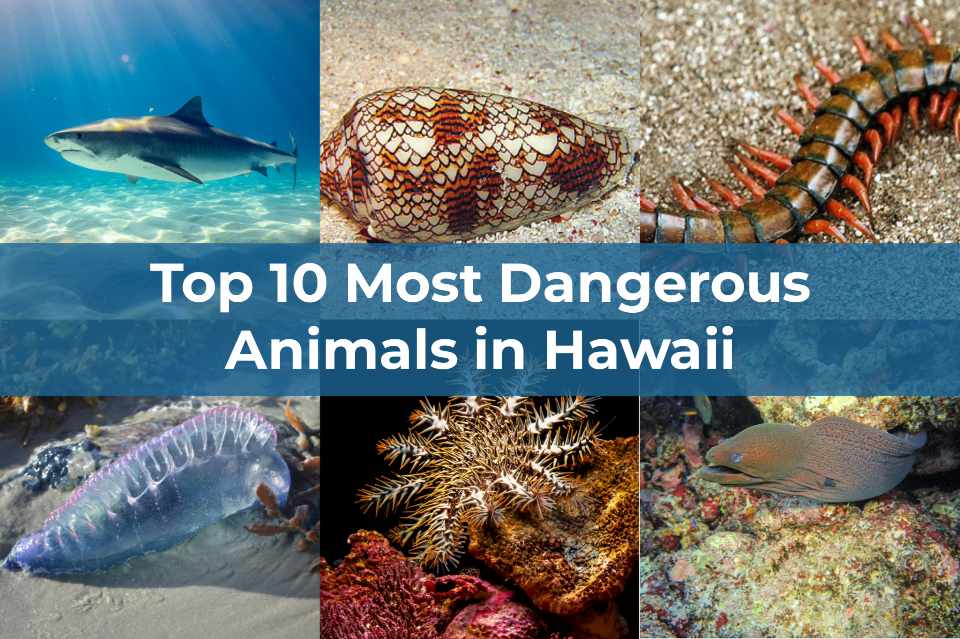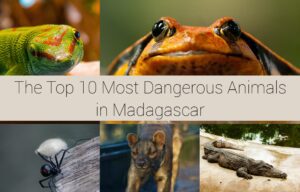Hawaii is a popular tourist destination for many travellers and vacations with family or spouse. We all love those crystal-clear waters and lush green landscapes.
Just like many other places in the United States and around the world, there are some dangerous wildlife that can be venomous, poisonous or even have a strong bite force.
These animals can be found in the warm waters or on land, and most of them can hide in dark places like under logs or leave litter.
In this article, we will take a look at the top 10 most dangerous animals in Hawaii. You will also learn why these animals are dangerous and how to stay safe.
The Top 10 Most Dangerous Animals in Hawaii
1. Tiger Shark (Niuhi)

Scientific Name: Galeocerdo cuvier
Tiger Sharks are also known as niuhi in Hawaiian. They are large apex predators that can reach 16 feet 5 inches in length.
Although shark attacks are rare in Hawaii, the tiger shark is responsible for the majority of incidents. These sharks will eat almost anything they come across in the water.
The diet of tiger sharks includes crustaceans, fish, seals, squid, turtles, sea snakes, dolphins, and even smaller sharks. It is very common for these sharks to mistake humans as prey, which leads to an attack.
Tiger sharks are also referred to as the garbage eaters of the sea. This is because they consume different disposed objects in the waters.
You are more likely to encounter tiger sharks during the fall months, particularly October, since they will be close to shore for pupping season.
The best way to stay safe from tiger sharks is to stay alert while in the water. Avoid murky waters and never swim alone at dawn or dusk when sharks are most active.

2. Box Jellyfish

Scientific Name: Carybdea alata
Another dangerous animal in Hawaii is the Box Jellyfish particularly the Carybdea alata species. These species are small, cube-shaped jellyfish with a box-like body and long trailing tentacles.
The box jellyfish has a very painful sting that can ruin your dreamy beach day. In Hawaii, box jellyfish are common on the shores and occasionally sting unsuspecting swimmers.
The tentacles of a box jellyfish are covered in tiny stinging cells called nematocysts. When these tentacles come in contact with your body, these cells will send venom into your skin that then results in a painful sting.
A sting can cause welts, itching, and, in some severe cases, difficulty breathing.
In Hawaii, the number of box jellyfish is higher approximately seven to ten days after a full moon. This is when they come near the shore to spawn.
Sometimes beaches like Hanauma Bay are closed due to an infestation of the box jellyfish.
If you will be swimming in Hawaii, you need to plan your trip to avoid visiting during the arrival of box jellyfish.
To stay protected when in the water, always wear protective clothing like pantyhose, full-body lycra suits, dive skins, or wetsuits.
If you do get stung, rinse the area with vinegar and then seek medical attention if the pain becomes unbearable.
3. Cone Snail (Pūpū Pōniuniu)

Cone snails are sea snails that are very venomous. In Hawaii, locals call them Pūpū Pōniuniu.
Cone snails have patterned shells that many tourists might think are beautiful. Picking one up can be very deadly to humans.
These slow-moving snails are highly venomous predators. They have a harpoon-like tooth that they can shoot out to inject a potent neurotoxin into their prey.
Species like the textile cone and the geography cone found in Hawaii have venom that is powerful enough to be fatal to humans.
Cone snails are nicknamed ‘cigarette snails’ with the grim humour that you would only have enough time for a smoke after being stung.
The worst part about the cone snail venom is that there is no known antivenom for their sting. Medical treatment is supportive only.
If you find a beautiful snail on the beach in Hawaii, do not pick it up and do not step on it.
4. Hawaiian Giant Centipede

Scientific Name: Scolopendra subspinipes
Hawaiian Giant Centipedes are very large centipedes found throughout Hawaii. They can grow up to 8 inches long and are extremely venomous.
Although Hawaiian giant centipedes are nocturnal and love dark places, they can also hide indoors in unsuspecting places.
They deliver venom into their victim through a painful bite. A bite can cause intense pain, swelling, and redness. The venom might not be life-threatening for adults, but it can be deadly for children and the elderly.
The best way to avoid a centipede bite is to always shake out your shoes or clothes after they have been left outside. If you are hiking, also be mindful of where you put your hands.
If you are bitten, wash the area with soap and water and apply a cold compress to reduce swelling. Seek medical treatment if the pain is unbearable or symptoms become severe.
5. Mediterranean Recluse Spider
Scientific Name: Loxosceles rufescens
Mediterranean Recluse Spiders are venomous spiders found in Hawaii and other parts of the world. These spiders live a solitary life and have a cytotoxic venom.
A bite from a Mediterranean recluse spider can cause tissue death that leads to a slow-healing ulcer. Although the bite might not be fatal, it will most likely require medical attention.
Mediterranean Recluse Spiders are not aggressive and will only bite if they feel threatened. So you are safe unless you intentionally mess with them.
You are most likely to have an encounter with these spiders when cleaning out a dusty shed or old closet.
6. Portuguese Man o’ War

Scientific Name: Physalia physalis
The Portuguese Man o’ War is also known as the man-of-war or bluebottle. They are marine hydrozoans found in the ocean.
You can easily recognise them by their blue, gas-filled bladder that floats on the ocean surface. Portuguese Man o’ Wars have venomous tentacles that can extend for several feet.
Once the tentacles come in contact with prey or human skin, the tentacles armed with stinging cells deliver a painful sting that can paralyse small fish and other prey.
Stings cause severe pain to humans that can last for one to three hours. Whip-like welts also appear on the skin and last two or three days after the sting.
Even when they are washed up on the beach, they can still deliver a painful sting when touched.
Always pay attention to warning signs and avoid them once you spot them on the sand. If you are stung, carefully remove any remaining tentacles without using your bare hands and rinse the area with saltwater.
7. Crown-of-Thorns Starfish

Scientific Name: Acanthaster planci
The Crown-of-Thorns Starfish is another dangerous aquatic animal found in Hawaii. They have venomous thornlike spines that cover their upper surface.
Those sharp spines are coated in a toxic mucus, which means a puncture can be incredibly painful and can cause bleeding and swelling. In some cases, the spines might break off in the skin, which can be difficult to remove.
An adult crown-of-thorns starfish can range in size from 10 to 14 inches with up to 21 arms. The spines can reach 4 to 5 cm long and are very sharp.
If you are snorkelling or diving, always be aware of your surroundings and avoid touching anything. If you are punctured, soak the wound in hot water to help break down the venom and then seek medical attention.
8. Sea Urchin (Wana)

Sea Urchins are another type of sea creature that are dangerous, mostly due to their sharp spines. They are also referred to as Wana in Hawaiian.
In Hawaii, wana or sea urchins are common in tide pools and rocky shorelines. Stepping on a sea urchin is a common and painful experience for beachgoers.
Although sea urchins are not fatal to humans, their spines can be venomous or cause infection.
If you ever get punctured by a wana, the local remedy is to soak the affected area in vinegar. The acidity helps to dissolve the spines, but you might need to see a doctor if the area is infected or some spines do not come out.
9. Feral Pig

Feral Pigs can be dangerous to humans, especially when they travel in herds with their young. They are found in the forests throughout Hawaii.
Although feral pigs are known to avoid humans, a sow with piglets or a cornered boar can be aggressive. They can use their sharp tusks to inflict serious injuries.
Some feral pigs may also carry diseases that can be transmitted to humans.
In 2019, a 59-year-old woman named Christine Rollins was attacked and killed by a herd of feral pigs in the town of Anahuac, Texas.
Feral Pigs are dangerous because they can attack without provocation, especially as group attacks. Just imagine getting puncture injuries from multiple feral pig tusks.
If you see a feral pig while hiking, give it plenty of space and back away slowly. Do not attempt to feed them because they can be unpredictable.
10. Moray Eel

Moray Eels are dangerous sea creatures and should be avoided when in the water. They have sharp teeth that can lead to muscle damage and also cause infection.
A bite from a moray eel can be extremely painful. This is due to their backward-curved teeth that are designed to grab slippery prey like fish and octopus.
You are more likely to get bitten by a moray eel when you try to feed them by hand. Some species also have toxic mucus on their skin or in their mouths that can slow healing.
If you are in the waters in Hawaii, do not stick your hands into crevices.
Notice that most of the dangerous animals in Hawaii are found in the water. This is because Hawaii is an island state of the United States, surrounded by water.
Conclusion
These are the top 10 most dangerous animals in Hawaii. Many people know Hawaii to be a wonderful island paradise, but some creatures can become a threat, especially if you are not cautious.
If you have read the article to this point, you now know some of the dangerous animals in Hawaii so you can stay prepared while planning your trip.
FAQs
Are there dangerous snakes in Hawaii?
No, there are no dangerous snakes in Hawaii. The only common snake found in Hawaii is the harmless Brahminy blind snake that looks like a small worm.
It is illegal to bring snakes into Hawaii. The highly venomous yellow-bellied sea snake may rarely wash ashore, but they are not native to Hawaii.
What is the largest predator in Hawaii?
The large predator in Hawaii is the tiger shark. They can reach 16 feet 5 inches in length.
I saw a warning about Leptospirosis. What is that and how can I avoid it?
Leptospirosis is a bacterial disease that can be contracted through contact with fresh water contaminated with the urine of infected animals like rodents and feral pigs.
The best way to avoid it is to avoid swimming in freshwater streams if you have open cuts or sores.
Is it safe to go hiking in Hawaii with all these creatures around?
It is safe to go hiking in Hawaii even with dangerous animals around. Make sure you stay on marked trails, wear sturdy shoes, and remain cautious.
Does Hawaii have alligators or crocodiles?
Alligators and crocodiles are not native to Hawaii. But you might see them in enclosed zoos.
Are there mosquitoes in Hawaii?
Yes, there are mosquitoes in Hawaii, but they are not native to the islands. Mosquitoes were introduced to Hawaii in the 1800s, and they are mostly found in warm, humid areas.
Some species can carry diseases like dengue and Zika. Use insect repellent and avoid standing water to prevent bites.

Hi, I’m Louis Ojibe, and I grew up around wildlife in Africa. I have always been fascinated by animals and nature across the world.
As a child, my parents used to take me to see wild animals like lions, elephants, gorillas, tortoises, and many others at our local zoo.












